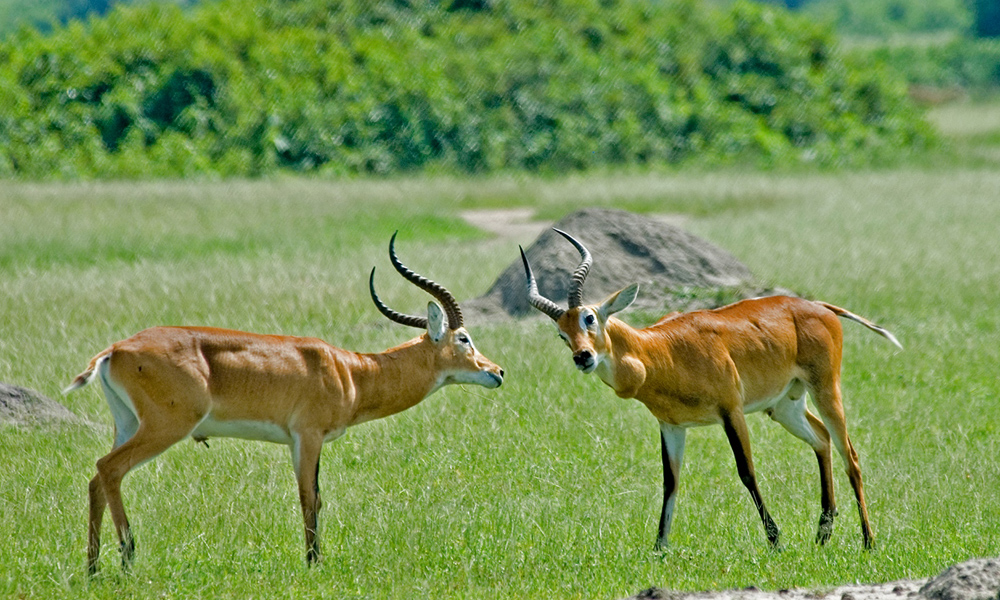The 2500 square km Akagera National Park is primarily Savannah territory located in eastern Rwanda. The Kagera River, which flows along Rwanda’s eastern border with Tanzania, is the source of the park’s name. The park’s surrounding smaller lakes, including Lake Ihema, receive water from the river.
The park preserves the acacia and woodland scenery of the African Savannah, together with a dozen marshy lakes and areas of open grassland. It creates a sizable protected wetland and has remarkably high biodiversity. The majority of Rwanda’s huge mammals may only be seen on safari at Akagera National Park, the country’s only Savannah national park. Although they exist in the other parks, it is quite difficult to see forest elephants. Take a game drive in the park in the luxury of your safari vehicle.

Game Drives in Akagera National Park
In the early morning, safari vehicles are used for game drives in Akagera National Park, where the goal is to spot lions, hyenas, and leopards that have been recaptured. Predators tend to hide when the sun gets hotter and prefer to prey at night or in the early morning. Enjoy the fauna of this stunning park, including antelopes, elephants, buffaloes, zebras, and giraffes, in addition to the carnivores. Photographers can find plenty of inspiration in the terrain and gorgeous wild flowers.
Additionally, the Akagera park officials, conduct nighttime game drives. These typically start at 6 p.m. and go for about two hours, ending at 8.30 p.m. A spotlight will be provided for you to use while observing the many nocturnal creatures. It’s possible that you’ll get to see lions or leopards during their hunting.
Bird watching in Akagera National Park
In Rwanda, Akagera National Park is a well-known and significant spot for birdwatching. Akagera National Park is a rewarding place for birdwatchers to go birdwatching since it provides possibilities to see both rare and endangered species of birds, such as the papyrus gonolek and shoebill, as well as more common species like egrets, weavers, and numerous Kingfishers. Birding can be done on a boat safari on Lake Ihema, during a wildlife drive, and on a nature walk led by a ranger. When birdwatching on Lake Ihema, one can observe aquatic species that are not typically visible during a game drive in the Savannah grasslands. Overall, because of the variety and simplicity of seeing birds at Akagera National Park, we heartily recommend birding there.
Boat safari on Lake Ihema in Akagera National Park
Taking a boat ride on Lake Ihema is the ideal way to spend a day at Akagera National Park. While some animals head to the lake to cool off and drink, the majority of animals are hiding beneath cover from the sun. Along with a variety of waterfowl, you can observe crocodiles along the lake’s edge and hippos in schools. While there are daily planned boat tours, guests can reserve a private, unscheduled boat trip for any time of day.
Cultural Tours near Akagera National Park
Discover life in rural Rwanda by visiting the villages that raise cattle close to Akagera National Park. You get the chance to watch or take part in customary activities such as milking, grazing, and storing milk in calabashes for preservation. After that, you process milk to make other products like ghee and traditional yoghurt, and you even get to cook a dinner using some of the milk product ingredients. The people who live next to the park get to benefit from this genuine cultural experience, which helps to complement their income from farming. In the end, this benefits the park’s wild creatures and conservation culture.
Rhino Tracking
In Akagera National Park, rhinos can be seen while taking a stroll through the jungle. Guests staying at the Karenge Bush Camp in the northern region of Akagera National Park can partake in this exclusive activity. Join the park’s rhino monitoring staff for their daily morning walkabout of the rhinos in the Kilala plains to ensure their well-being and safety. A minimum of two and a maximum of four people may participate. Unlike the black rhinos that inhabit the southern part of the park, the white rhino species that is being tracked is not violent. Thus, rhino attacks are not anticipated.
